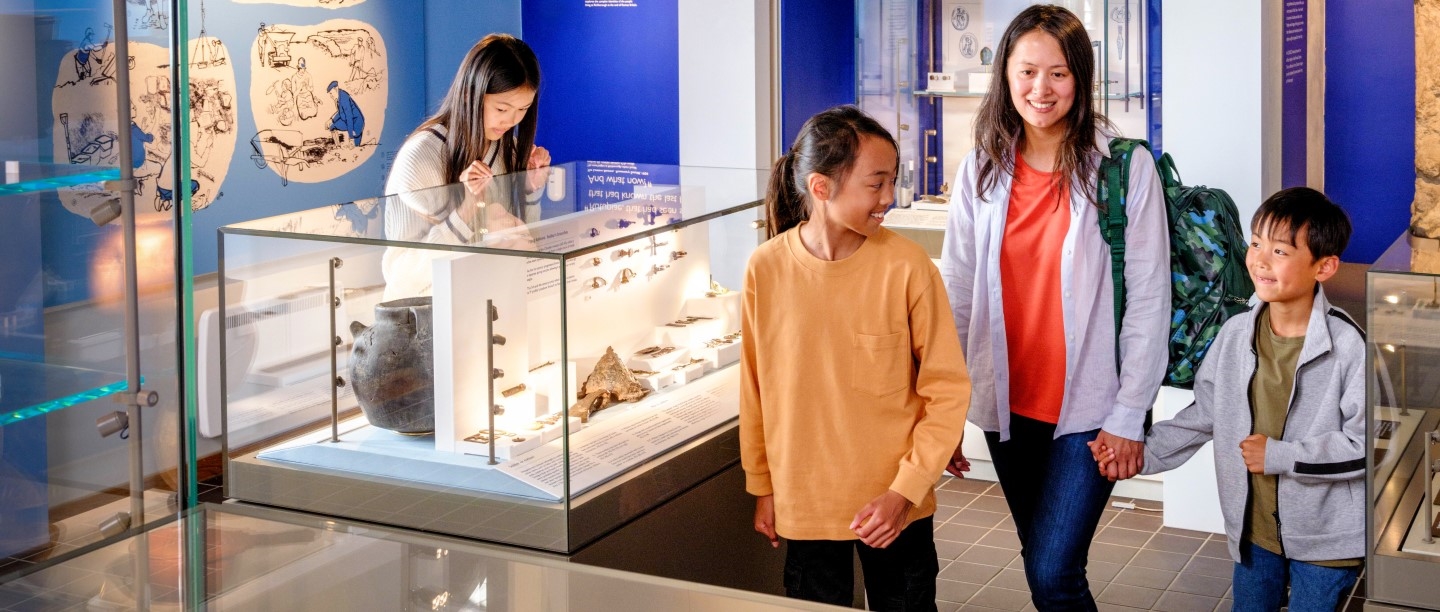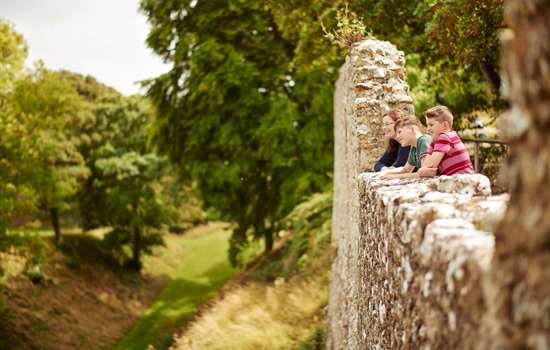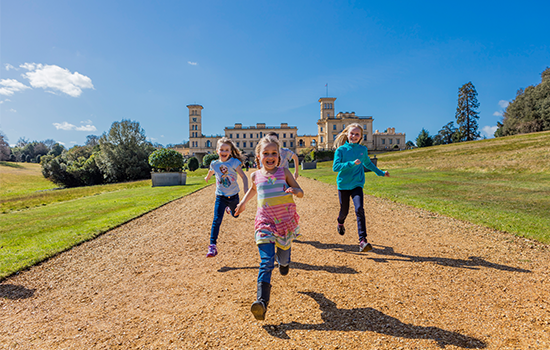Featuring objects and stories that paint a vivid portrait of life through the ages, the museums at English Heritage sites provide the perfect opportunity to take a deeper dive into their history. And with interactive exhibits and immersive storytelling, there's something for visitors of all ages. If you’ve yet to venture inside to discover their treasures, the new and refreshed museums at Richborough Roman Fort and Amphitheatre in Kent, Wroxeter Roman City in Shropsire and Lindisfarne Priory on Holy Island in Northumberland are the perfect places to start.
The Gateway to Britannia project at Richborough Roman Fort not only saw Richborough’s museum revitalised but the interpretation reinvigorated, the amphitheatre excavated and a replica Roman gateway constructed. Richborough is where the Romans first arrived in Britain in AD 43 and was still occupied in the early part of the 5th century. Over those 360 or so years, it served as a fort, a town and a thriving port. You can get some marker of its importance by the fact that at its centre lie the foundations of a triumphal arch – one of the biggest in the Roman Empire.
‘Richborough was a gateway to Roman Britain for people coming from across the empire,’ says properties historian Dr Andrew Roberts. ‘But we also conceive it as a metaphorical gateway – it is one of the best places to get an introduction to Roman Britain.’ The first things you see when you arrive are the stone shore fort walls, built after AD 275. A path leads to the visitor centre, which was once the custodian’s cottage. The building has been redesigned, with the museum now occupying a bright and airy space, alongside an education room and shop.
It’s not just the museum’s configuration that’s changed – its contents have too. They now give a broader understanding of the location, its people and its varied history. While the first half of the space is themed around ‘connections’, looking at Richborough’s role within Roman Britain, the second half focuses on ‘identity’ and the people who lived in the fort, port and town. On entering, a short film details the chronology, while characterful illustrations of the inhabitants of Richborough, as well as of those working on recent excavations, adorn the walls. On display is a wealth of artefacts, ranging from a limestone statue of a goddess to a soldier’s brooch.
‘If you’d visited the former museum, you’d be justified in thinking the Richborough collection was ceramics, building materials and not a lot else,’ says collections curator Dr Kathryn Bedford. ‘You wouldn’t have seen the metals – brooches, weights, the post-Roman sword – mainly because the display cases didn’t have the right environmental controls that the new ones do.’
Particularly fascinating are the objects that likely belonged to women: hairpins, armlets, ligulae for mixing cosmetics and phials for perfumes. ‘We’d like visitors to be able to appreciate the great richness and variety at Richborough in terms of the people who lived there – and the people travelling through,’ says Bedford.
The interactive additions include a digital game that allows you to trade various goods across the Roman Empire and an opportunity to recreate a miniature version of Richborough’s huge arch in a race against an opponent. ‘The exhibition has many layers,’ says Roberts. ‘If you want to get the big picture, you can watch the film and have a bit of a browse. But there’s a lot of detail if you really want to dive into the collection.’
Other changes across the site include the replica Roman gateway, reconstructed on the exact spot of an original fortification built in AD 43, which stands eight metres high. ‘There was little to show the significance of Richborough as the beginning of the Roman invasion and we wanted to mark this out,’ says senior properties historian Paul Pattison, who masterminded the project. ‘We also wanted to give people an elevated view so they can better see how the site changed during the Roman era.’
Within the walls and defensive ditches, the ruins of the chapel and bathhouse are brought to life by refreshed interpretation and an audio tour. It features Dr Andrew Roberts in conversation with historian Dr Tessa Dunlop, with guest appearances to help make connections between past and present, including boxer Chev Clarke, who gives a different perspective on the amphitheatre.
‘Gateway to Britannia is a holistic revamp of the whole site,’ says Pattison. ‘We hope there’s something for everyone. We’d like the visitor to better understand what Richborough was in Roman times, as well as who the Romans were beyond the stereotype of a bloke in uniform with a crested helmet and a sword.’
The Gateway to Britannia project is supported by the National Lottery Heritage Fund
Book a visit to Richborough Roman Fort & AmphitheatreWere you to leave Richborough and follow Watling Street – one of Roman Britain’s greatest roads – it would eventually bring you to Wroxeter, or Viriconium Cornoviorum as it was known two millennia ago, when it was one of the largest cities in Britannia.
This Shropshire site is still impressive today, home to some of the largest upstanding remains in the country, not least a seven-metre-high basilica wall. Visitors can wander the ruins of the bathhouse and market hall, while a reconstructed town house is next to the site of the forum. ‘What is special about Wroxeter is that it gives this snapshot of urban life,’ says Roberts.
The museum here has also been revitalised. ‘The arrangement is completely new with an individual display case for each of the buildings,’ says curator of collections Cameron Moffett. ‘It’s unusual to approach it this way rather than chronologically, but we have focused on the 2nd and 3rd centuries, the city’s heyday.’
Half of the objects now on display are never-before-seen, chosen by Moffett to help the visitor realise that ‘these are people who have tastes like me, who maybe wear jewellery like me, who play games like me.’ Standout objects include a lapis lazuli bead that would have been mined in Afghanistan, traded through ports in India, eventually making its way to Rome and finally on to Britain.
To help visualise Wroxeter’s townsfolk, various Roman characters have been woven into the interpretation across the site including a wealthy family, traders, slaves and even a witch. Interactive games, a projection and an audio guide all add to the experience. ‘The museum is absolutely essential in telling the story of Wroxeter,’ says Moffett.
Book a visit to Wroxeter Roman CityThe Romans aren’t the only ones being given a fresh spin. At Lindisfarne Priory, the Anglo-Saxons are getting a look-in too. Wildly beautiful, it was once the home of a 7th-century monastery and later a 12th-century priory, the remains of which you can see today. The site played a pivotal role in early Christianity, and many of its monks became saints, including Aidan and Cuthbert. To this day, people make the pilgrimage to the site of St Cuthbert’s original resting place.
Visitors will find plenty to see in its refreshed museum. New artefacts on display include those from a recent excavation, such as a salmon-bone necklace and a blue glass Tafl gaming counter, both from the 9th century. There are also now 21 engraved name stones (unique to Lindisfarne), while a Viking Raider Stone, thought to depict the first Viking raid on the monastery in AD 793, is displayed in a new case.
A series of recently commissioned pieces is a particular highlight. The first is an audio poem, The Refuge Box by Katrina Porteous, which visitors can download or sit and listen to. In addition, the artist Olivia Lomenech Gill, who illustrated JK Rowling’s Fantastic Beasts, has created a mixed-media work, Shifting Sands, which takes inspiration from the island’s history as a place of pilgrimage.
Lomenech Gill has also created six illustrations of birds and beasts based on the priory’s illuminated manuscript, The Lindisfarne Gospels, which are part of a family trail. Outside, sculptor Russ Coleman has created a memorial to Cuthbert that sits within the presbytery ruins.
‘It’s a huge transformation of the space – it now has the look and feel of a bright, modern museum,’ says collections curator Susan Harrison. ‘The objects are beautifully displayed and lit, enabling visitors to really appreciate the history of Lindisfarne and to better understand the significance of Holy Island, and the part Lindisfarne Monastery and Priory played in Christianity.’
Book a visit to Lindisfarne PrioryMore to explore
Four more amazing museums to visit across the country
-

Whitby Abbey, North Yorkshire
This splendid abbey was a source of inspiration for Bram Stoker’s Dracula. There’s plenty to sink your teeth into at the museum – even a signed copy of Stoker’s novel.
-
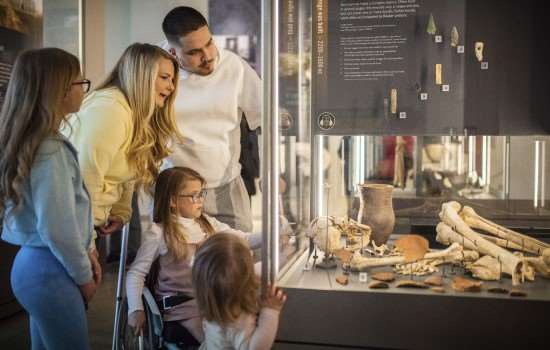
Stonehenge, Wiltshire
The visitor centre brings the story of the stone circle to life with a display of over 250 archaeological treasures, combined with cutting-edge audio-visual experiences.
-
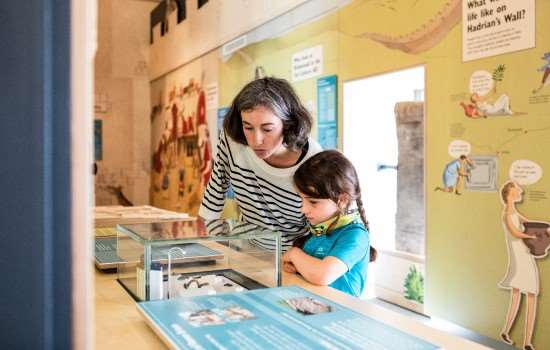
Birdoswald Roman Fort, Cumbria
The museum offers a masterclass on what it was like to be a soldier of the Empire, with artefacts and hands-on interactives for all ages.
-
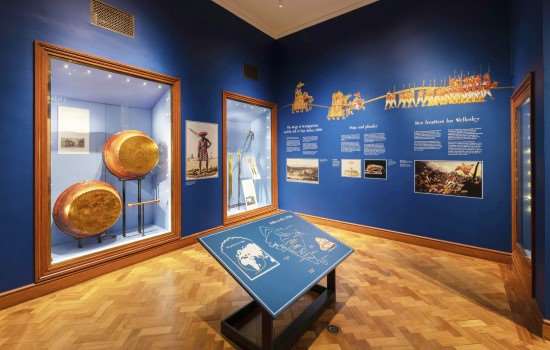
Apsley House, London
See the 1st Duke of Wellington’s famous paintings and magnificent art collection, and discover a wealth of fascinating memorabilia including medals and shields.
